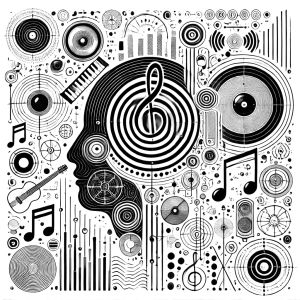InnerMotion – The Guidebook – Music Focus

The essence of intuitive dance lies in creating a profound bond with the music you hear. Instead of performing a predetermined set of steps, you respond spontaneously to the layers of sound, letting each beat and note guide your body’s movements. This approach transcends technique, integrating insights from music cognition, neuroscience, and psychology to deepen and enrich your dance experience.
- Begin with the Beat: Start simple. Put on a piece of music and focus exclusively on its fundamental pulse - the steady, underlying beat that anchors the entire track. This might mean concentrating on the drum pattern or the soft thump of a bass line. Research in music cognition (e.g., Phillips-Silver & Trainor, 2005) has shown that humans naturally entrain to a musical pulse, synchronizing our movements and attention with the beat. By isolating the beat first, you establish a solid foundation for your dance, helping your body find its innate rhythm before exploring anything more complex.
- Add a Second Layer - Melody or Harmony: Once you feel comfortable moving with the beat, expand your listening to include another layer of the music, such as the melody carried by a vocal line or a lead instrument. Notice how the melody interacts with the rhythm. Perhaps it floats above the steady beat, dips beneath it, or weaves in and out, adding emotional color. Studies in music psychology have shown that attending to melody and harmonic progressions engages different regions of the brain (Levitin, 2006). As you tune in to these melodic contours and harmonies, let them influence the shape and quality of your movements - maybe a fluid arm gesture for a soaring note, or a gentle sway for a smooth chord progression.
- Introduce Textures and Timbres: Next, shift your attention to more subtle qualities of the music: the unique sound of each instrument, the texture created by multiple layers playing simultaneously, and the interplay of different rhythms. In many genres, percussion layers, ambient sounds, and background chords add richness and complexity. Focus on how these layers make you feel physically and emotionally. Neurological studies suggest that paying attention to timbre and texture can enhance emotional engagement with music (Zatorre & Salimpoor, 2013). Let these nuances guide smaller, more detailed movements - perhaps a gentle ripple through your spine or a delicate fingertip motion that mirrors the soft rustle of a shaker or the whisper of a synth pad.
- Observe Transitions and Dynamic Changes: Now begin to anticipate changes in the music - those moments when a verse transitions to a chorus, a sudden drop occurs in electronic music, or a crescendo builds tension before releasing into silence. Recognizing and responding to these shifts can heighten your sensitivity to form and phrasing. By syncing your movements with these transitions, you not only stay aligned with the music’s narrative but also train your body to adapt and react fluidly. Research in performance psychology suggests that attuning to musical form enhances both performer and listener satisfaction (Juslin & Sloboda, 2010).
- Close Your Eyes and Feel the Sound: For a deeper level of immersion, try dancing with your eyes closed once you feel comfortable. Removing visual distractions intensifies your auditory focus and encourages a more direct body-to-music connection. With eyes closed, you may notice details in the music you missed before - tiny echoes, subtle reverberations, or slight shifts in volume. Such practices align with mindfulness-based approaches found in music therapy, which emphasize present-moment awareness and heightened sensory integration.
- Breathing and Body Awareness: Consider your breath as an additional pathway to musical immersion. Slow, deep breaths can help regulate your nervous system, reducing tension and anxiety. As you inhale, imagine drawing the music into your body; as you exhale, let your movements flow outward, guided by the melody or beat. Research in somatics and dance therapy shows that breath awareness improves emotional regulation and enhances kinesthetic empathy, allowing you to move more freely and intuitively.
- Expressing Emotional Resonance: Finally, notice how the music makes you feel. Does it bring joy, nostalgia, excitement, or calmness? Allow these emotions to surface and inform your movements. Maybe a soft piano passage invites a gentle sway, or a driving techno beat encourages energetic footwork. Studies in affective neuroscience indicate that when we move in ways that mirror our emotional state, we strengthen our mind-body connection and foster psychological well-being.
By slowly introducing each layer - first the beat, then the melody, then textures and timbres, and finally dynamic changes and emotional nuances - you train your ear and body to work together more intimately. Scientific research supports this layering approach: it engages multiple auditory and motor regions in your brain, promoting a richer, more immersive experience. Over time, you’ll find that this careful, step-by-step immersion leads you to dance more intuitively, with movements that genuinely reflect your inner state rather than external expectations.
What emerges is a symbiotic relationship between dancer and music. You become both an attentive listener and an active participant, translating auditory cues into meaningful movement. As you refine this skill, dancing transforms into a holistic practice - one that nurtures emotional depth, self-awareness, and authentic physical expression.